Plan for Water Management in Australia’s Murray-Darling Basin Signed Into Law
The Australian House of Representatives passed the major initiative late last year, but some states are fighting back.
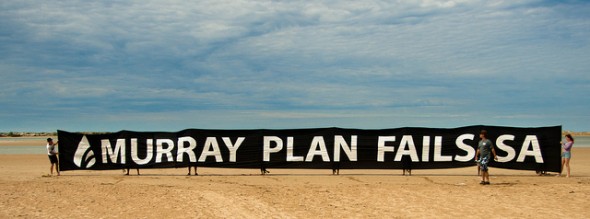
Photo courtesy of wildernessSA via Flickr Creative Commons The Wilderness Society South Australia gathered at the mouth of the Murray River on November 28, 2011, with local fishers, farmers, and environmentalists to call for more water to be returned to the Murray-Darling river system. Photo courtesy of wildernessSA via Flickr Creative Commons
It may have been a long process, but there is now a tangible set of water use regulations for the ailing Murray-Darling Basin, Australia’s largest and most economically productive agricultural region. The federal government passed its water management plan in November 2012, approving the final version of a plan first drafted in November 2011, then revised in May and again in August of last year.
The plan is a critical component of the country’s water policy. It aims to balance environmental and socio-economic interests in a highly productive region that suffers both intense floods and dire droughts. Adding to the plan’s significance, the Murray-Darling lies at the heart of Australia’s progressive water trading market.
“Buyback is the simplest and most convenient and possibly the laziest option for the government.”
–Katrina Hodgkinson, New South Wales’ minister of primary industries
One month after the House of Representatives passed the plan, Australian water sector leaders hailed the new law in a video posted in December on the national government’s Web site. From government officials to scientists to industry representatives, each praised the agreement as a compromise resolving years of vociferous debate over the best ways to provide for the Murray-Darling’s massive agricultural industry while protecting the entire ecosystem’s longevity.
Yet, even in the earliest stages of implementation, political maneuvering continues within the Basin while the rest of the world watches, intent to see how one of the largest conservation projects ever will fare.
What’s New?
One number sits at the core of the new plan: 2.75 billion cubic meters (725 billion gallons), or the total volume of surface water that the Australian federal government intends to return to the Murray-Darling Basin by 2019.
The government will devote $US 1.77 billion to the effort, which will purchase three things: water rights from current users that will be reserved for the environment, updates to irrigation infrastructure, and smarter water management, National Geographic reported.
Tony Burke, Australia’s minister for water, has promised that, by 2024, the plan will save an additional 450 million cubic meters (120 billion gallons) of water every year through the investments in irrigation system and efficiency upgrades, according to the Australian Broadcasting Company.
Under current conditions, Burke said the rivers are “living as though it’s drought ages before the drought itself actually arrives.” He also projected that the Basin could lose roughly 10 percent more water to climate change over the next 20 to 30 years, despite the plan’s improvements.
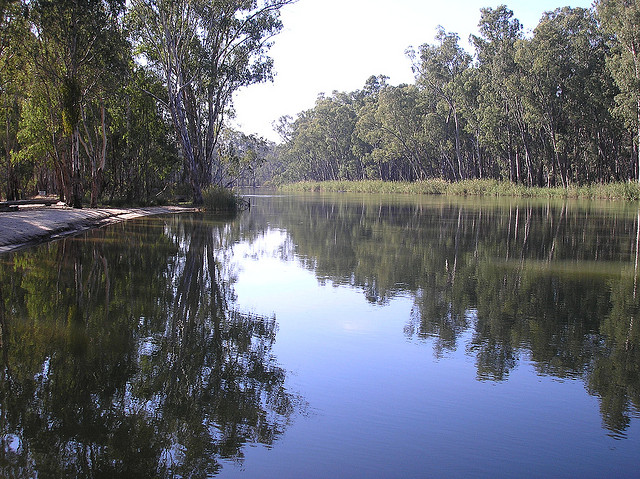
The Murray River as it flows through Picnic Point near Mathoura, New South Wales. Photo courtesy of wazzas world via Flickr Creative Commons
Other elements in the plan include a mandate to regularly assess risks to the Basin from climate change; a groundwater-related revision to water trading rules; and a new provision requiring New South Wales and Victoria — two states out of four that have territory within the Basin — to review groundwater-withdrawal limits.
Still, if the new plan achieves its stated goals, the Basin’s health will improve, according to a statement by Tom Hatton, an executive at CSIRO, Australia’s largest national science agency, in the federal government’s video release. Hatton said modeling predicts that water will flood back into forests and private lands, wetland health will improve, and more salt from the Basin will be flushed out to sea.
Fitful State Implementation
The November agreement may have passed with high-level endorsement, but state governments are already fighting back against implementation in the new year.
On January 14, Bloomberg reported that New South Wales — Australia’s largest cotton producer — would this year begin limiting the amount of water rights that the federal government can buy back for the environment from users in that state. A state ministerial order set the limit at 3 percent of the total available rights per valley per decade, the Australian Broadcasting Company reported.
The Australian government, according to a statement by Katrina Hodgkinson, the state’s minister of primary industries, “has ignored the very real concerns of New South Wales Basin communities about the potential size and pace of an environmental water-buyback program.” Rural economies, she said, will be better able to adjust to the environmental reserve program with the 3-percent limit.
Hodgkinson also hoped the state’s cap would pressure the federal government to fund water-saving infrastructure investments, the ABC reported, rather than focusing on buybacks, which she called “the simplest and most convenient — and possibly the laziest — option for the government.”
In late December, the state of South Australia also pushed back against the Basin plan. A state ministerial order cut $US 14.6 million of the funding slated for water-rights purchases in 2014-15, Adelaide Now reported. That amount is half of the state’s promised financial contribution to the Basin plan’s federal funding.
Feds Respond
Murray-Darling Basin and federal officials shot back, however. Craig Knowles, chair of the Murray-Darling Basin Authority, said in a statement that South Australia’s decision “further unravels an historic co-operative and internationally recognized agreement.” Meanwhile, a federal spokesman called South Australia’s premier a “complete and utter hypocrite.”
“Unless you’re able to use water economically — and derive value out of using it — perhaps you shouldn’t be using it at all.”
–Kim Morison, managing director Blue Sky Alternative Investments
On the other hand, the state of Victoria is embracing the plan and has initiated its first project. A $US 583 million plan will simulate natural flooding across 6,000 hectares (14,800 acres) in northwest Victoria. The state will also fund irrigation infrastructure upgrades to help make more water available for the Basin plan’s environment quota, The Age reported.
Despite the ongoing disagreements between some state and federal officials on the plan’s implementation, few in Australia are questioning the fundamental premise behind the Basin plan that a government-regulated free market is the best system — socially, economically, and environmentally — to allocate a scarce water supply.
Kim Morison, managing director of a water investment firm in Australia, explained the fundamental economic rationalist point of view to Circle of Blue.
“Unless you’re able to use water economically — and derive value out of using it — perhaps you shouldn’t be using it at all,” Morison said.
Source: Australian Department of Sustainability, Environment, Water, Population and Communities; National Geographic; Australian Broadcasting Company (2,3); Adelaide Now; The Age
is a Washington, D.C–based correspondent for Circle of Blue. He graduated from DePauw University as a Media Fellow with a B.A. in Conflict Studies. He co-writes The Stream, a daily summary of global water news.


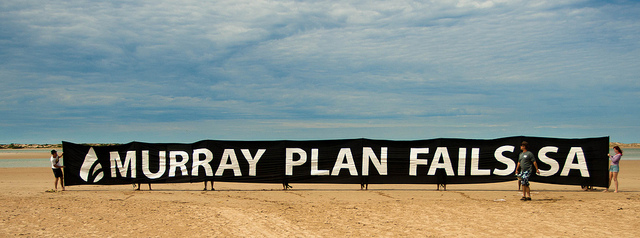
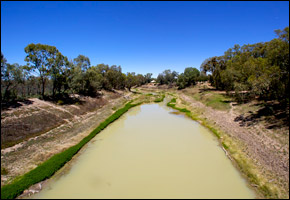
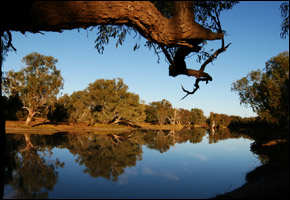

Leave a Reply
Want to join the discussion?Feel free to contribute!